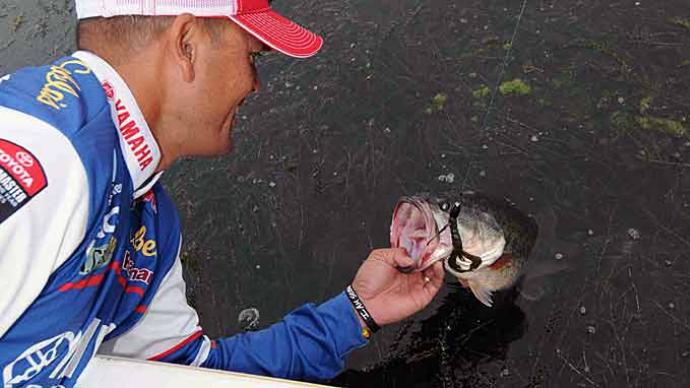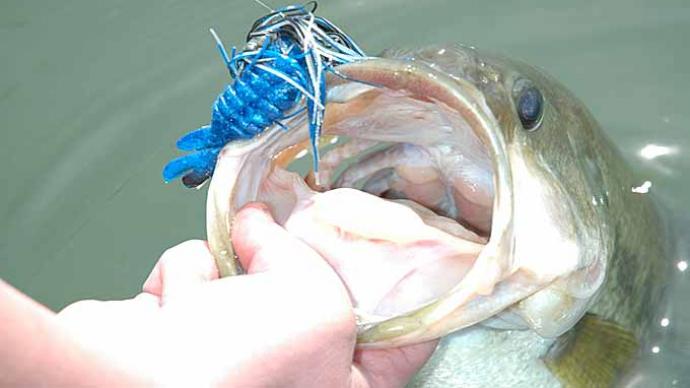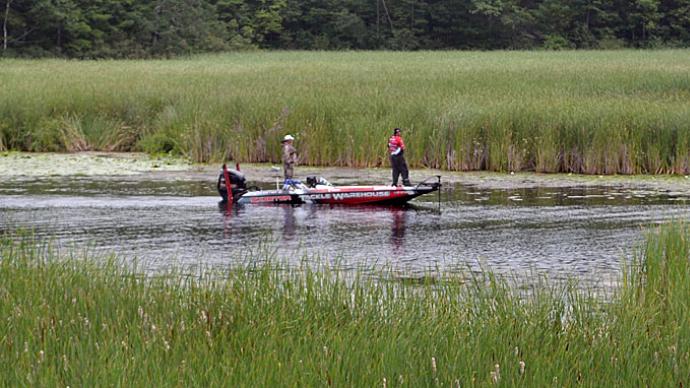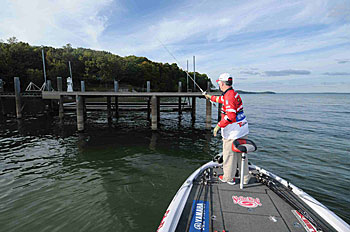
Pitching has become the most popular tactic among the pros for close-range lure presentations, but there are still situations when they rely on old-school flipping to deliver a lure to bass burrowed in thick cover.
“The most frequent times that I flip anymore is punching vegetation,” Bassmaster Elite Series pro Mark Menendez says. “Everything else is pitching, which is quicker and more efficient, and I can keep a safe distance from the fish.”
Both flipping and pitching are underhand deliveries that can be achieved in a few basic steps. For flipping, Menendez starts his presentation by holding the line near his reel with his left hand and extending that hand out as far as possible so he will have about a rod length of line out. He puts his lure in motion by dropping his rod tip and swinging the lure out so it pendulums toward the target.
“The key is how silent you put the bait in the water,” he says. “That allows you to get closer to the fish and have better control of the fish once you hook up.”
Punching vegetation requires the same basic steps as flipping, but sometimes, Menendez sends his Texas-rigged soft plastics with a 1-ounce or 1 1/4-ounce weight airborne to punch through a thick mat.
“Sometimes you can’t get your bait through it, so you have to flip it up high in the air to be able to get enough momentum to punch it on through when it hits the mat,” he says.
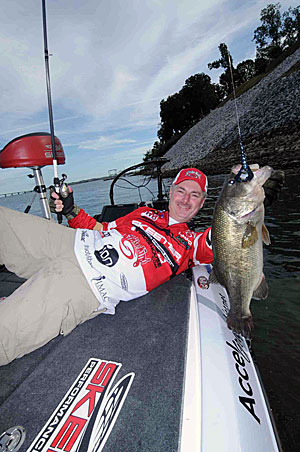
The B.A.S.S. pro notices the three biggest mistakes beginning flippers make: trying to handle too much line at one time, making too long of a flip (more than 15 feet), and poor placement of the bait. He believes a key to flipping is thoroughly working a piece of cover before moving on to the next target. For example, when Menendez flips a laydown tree, he never starts at the tree's heart unless it has shady spots. He usually flips the edges first to catch any fish holding in the limbs and branches before he moves in to flip the trunk.
Pitching a lure requires a few different steps than flipping. “The first thing I recommend is to turn your reel to whichever side the reel cover is closest to the water,” Menendez says. “That allows the line to come off the spool easily for more distance and control. Never bring the lure in the opposite hand that you are holding the rod back any farther than the reel. Bringing it behind the reel will be very cumbersome, and you will not be nearly as accurate. It will be difficult to keep the bait in control then.”
While holding the sinker in his left hand, Menendez drops his hand and rod tip in the same motion and then quickly lifts the rod to create the momentum to propel the lure towards his target. “As an angler gets better at the technique, he doesn’t even touch the lure as it comes back (for the next pitch), Menendez says. “I can make much more efficient pitches during a day and many more presentations by not touching the lure.”
The Kentucky pro believes the key to pitching is using a light tip, which allows the rod to load up on the bait and propel it more easily. Fine-tuning the magnets and casting control of the baitcast reel is also crucial to pitching. Menendez suggests you can determine if the reel is fine-tuned by holding the rod level with the lure close to the rod tip and then letting the lure fall to the floor of the boat. The reel controls are set correctly if the line falls quickly and never backlashes when it hits the floor. “You want that reel to be very light and flowing to give you extra distance,” he says.
In recent years, Menendez’s favorite flipping and pitching lure has been the Strike King Rage Craw. “It has a big enough profile that I will get a strike from a big fish, and it is still small enough that you can catch a lot of keepers on it,” says Menendez, who also favors a 4-inch Strike King Game Hawg for his close-range presentations.
“Our waters seem clearer than they used to be, so overall soft plastics have been more effective than jigs for me,” Menendez says. “But that jig bite is still viable and relevant at the right time,” Menendez recalls on the final day of the 2015 Bassmaster Elite Series on the Chesapeake Bay. When bass stopped biting the Game Hawg, he switched to pitching a 1/2-ounce Strike King Hack Attack Jig and caught a 12-pound limit to finish in ninth place.
Water temperature determines how Menendez retrieves his pitched and flipped lures. If the water temperature is around 68 to 70 degrees, Menendez shakes the lure several times and lets it fall to the bottom. Then he lifts it and reels in to pitch to another target. “As the water temperatures warm, I tend to soak the bait a lot longer,” he says. “If I feel confident a fish is there, I may let it sit for 15 to 20 seconds without moving it.”
The touring pro uses the same tackle for pitching and flipping, starting with a 7-foot-, 6-inch moderate-action Lew’s Custom Speed Stick rod. “What I have found over the last six to 10 years of using moderate-action rods versus a fast-tip flipping stick--which can be slightly more accurate--is that with the moderate rod, when I hook up, and the fish pulls away from me, that rod loads up into a bigger and deeper arc and I lose less fish.”
Menendez matches the rod with a Lew's Team Pro SP Speed Spool Casting reel, weighing only 6 ounces. “This is a heavy bait and cover technique, so I need a light responsive rod and reel, so I don’t create too much fatigue in my arms,” Menendez says. The reel also has a fast gear ratio (8.3:1) for picking up line quickly to either make another pitch or catch up with a fish that has engulfed the lure and is swimming towards him. He fills his line with 25- to 30-pound Seaguar Smackdown line for flipping and 17- to 20-pound Seaguar Invizx fluorocarbon for pitching.
BassResource may receive a portion of revenues if you make a purchase using a link above.


